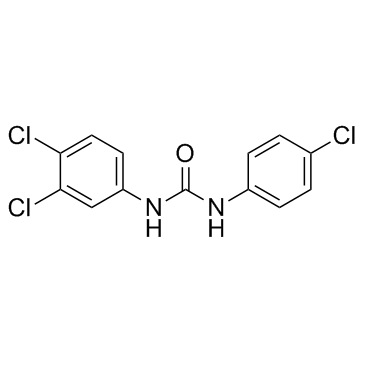Triclocarban

Triclocarban structure
|
Common Name | Triclocarban | ||
|---|---|---|---|---|
| CAS Number | 101-20-2 | Molecular Weight | 315.582 | |
| Density | 1.4±0.1 g/cm3 | Boiling Point | 475.3±55.0 °C at 760 mmHg | |
| Molecular Formula | C13H9Cl3N2O | Melting Point | 254-256 °C(lit.) | |
| MSDS | Chinese USA | Flash Point | 241.2±31.5 °C | |
| Symbol |

GHS09 |
Signal Word | Warning | |
|
Intraplacental gene therapy with Ad-IGF-1 corrects naturally occurring rabbit model of intrauterine growth restriction.
Hum. Gene Ther. 26(3) , 172-82, (2015) Intrauterine growth restriction (IUGR) due to placental insufficiency is a leading cause of perinatal complications for which there is no effective prenatal therapy. We have previously demonstrated that intraplacental injection of adenovirus-mediated insulin-... |
|
|
SPREDs (Sprouty related proteins with EVH1 domain) promote self-renewal and inhibit mesodermal differentiation in murine embryonic stem cells.
Dev. Dyn. 244(4) , 591-606, (2015) Pluripotency, self-renewal, and differentiation are special features of embryonic stem (ES) cells, thereby providing valuable perspectives in regenerative medicine. Developmental processes require a fine-tuned organization, mainly regulated by the well-known ... |
|
|
Regulation of phagocytosis and cytokine secretion by store-operated calcium entry in primary isolated murine microglia.
Cell. Signal. 27(1) , 177-86, (2015) Microglia are immune effector cells in the central nervous system that participate in tissue repair, inflammatory responses, and neuronal degeneration. The most important signaling factor in the differentiation of immune-active cells after stimulation is the ... |
|
|
Altered Oligodendrocyte Maturation and Myelin Maintenance: The Role of Antiretrovirals in HIV-Associated Neurocognitive Disorders.
J. Neuropathol. Exp. Neurol. 74 , 1093-118, (2015) Despite effective viral suppression through combined antiretroviral therapy (cART), approximately half of HIV-positive individuals have HIV-associated neurocognitive disorders (HAND). Studies of antiretroviral-treated patients have revealed persistent white m... |
|
|
Upregulation of Stat1-HDAC4 confers resistance to etoposide through enhanced multidrug resistance 1 expression in human A549 lung cancer cells.
Mol. Med. Report. 11(3) , 2315-21, (2014) Despite efforts to develop efficient chemotherapeutic drug strategies to treat cancer, acquired drug resistance is a commonly encountered problem. In the present study, to investigate this phenomenon, human A549 lung cancer cells resistant to the topoisomeras... |
|
|
Effects of nitric oxide synthase deficiency on a disintegrin and metalloproteinase domain-containing protein 12 expression in mouse brain samples.
Mol. Med. Report. 12 , 2253-62, (2015) A disintegrin and metalloproteinase domain-containing protein 12 (ADAM12) belongs to the ADAM family of transmembrane proteins. Via proteolysis, cell adhesion, cell-cell fusion, cell-matrix interaction and membrane protein shedding, ADAM proteins are involved... |
|
|
Curcumin inhibits anchorage-independent growth of HT29 human colon cancer cells by targeting epigenetic restoration of the tumor suppressor gene DLEC1.
Biochem. Pharmacol. 94(2) , 69-78, (2015) Colorectal cancer remains the most prevalent malignancy in humans. The impact of epigenetic alterations on the development of this complex disease is now being recognized. The dynamic and reversible nature of epigenetic modifications makes them a promising ta... |
|
|
The Tumor Suppressor BCL7B Functions in the Wnt Signaling Pathway.
PLoS Genet. 11(1) , e1004921, (2015) Human BCL7 gene family consists of BCL7A, BCL7B, and BCL7C. A number of clinical studies have reported that BCL7 family is involved in cancer incidence, progression, and development. Among them, BCL7B, located on chromosome 7q11.23, is one of the deleted gene... |
|
|
Ficolins and the lectin pathway of complement in patients with systemic lupus erythematosus.
Mol. Immunol. 63(2) , 209-14, (2014) The complement system plays a pathophysiological role in systemic lupus erythematosus (SLE). This study aims to investigate whether an association exists between the ficolins that are part of the lectin complement pathway and SLE. EDTA plasma samples from 68 ... |
|
|
Induction of human breast cell carcinogenesis by triclocarban and intervention by curcumin.
Biochem. Biophys. Res. Commun. 438(4) , 600-6, (2013) More than 85% of breast cancers are sporadic and attributable to long-term exposure to environmental carcinogens and co-carcinogens. To identify co-carcinogens with abilities to induce cellular pre-malignancy, we studied the activity of triclocarban (TCC), an... |